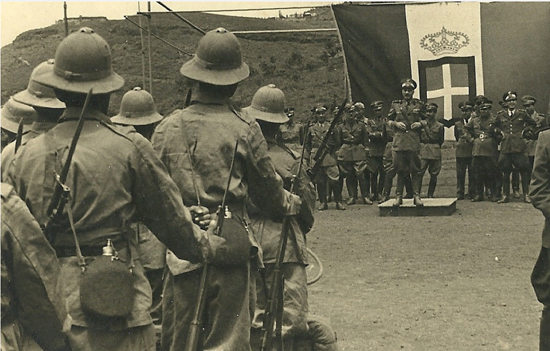It wasn’t just the Europeans or the Japanese who utilized khaki, as so too did the American military, which first adopted khaki during the Spanish America War in 1898. Until that time the United States Army was outfitted with the M1883 fatigue blouse in blue. However, the large numbers of volunteers – as well as the fact that soldiers were falling prey to heat exhaustion and dehydration – forced the army to experiment with lighter-colored and lighter-weight materials. The United States thus adopted the “khaki cotton drill” and in 1903 the army authorized these as the official hot weather fatigue and field dress. Continue reading
Author Archives: Peter Suciu
The Original Camouflage: Khaki Part VI – Khaki’s Use in the Empire of the Rising Sun

The Japanese army’s advance on Singapore in late 1941/early 1942 – the khaki uniforms were well suited to the climate
While the European powers utilized khaki during the scramble for Africa and in the final decades of the age of imperialism, it was used in the Pacific as well – by both the United States and the Empire of Japan. The former followed British and European patterns beginning towards the end of the 19th century, while the latter adopted it as it went to war with a major European power at the beginning of the 20th century. Continue reading
The Original Camouflage: Khaki Part V – Khaki in Colonial Africa and the Middle East

Portuguese soldiers in Africa during World War I wearing the newly introduced khaki 1900 pattern uniform
Khaki was used throughout the colonial world by most of the major powers, and in many ways the First World War was the first conflict where the parties fought with virtually the same colored uniforms. While khaki, as we noted in part I of this feature on The Original Camouflage, was introduced in India, other powers including France and Germany – as noted in previous posts – also opted for the dust-colored fabric. Other armies, including the Belgians, Portuguese, Spanish and Turks would don khaki colored uniforms. Continue reading
The Original Camouflage: Khaki Part IV – Colonial Italy’s Khaki Uniforms
The Italians, like the Germans, were late to the colonial empire rush but established colonies in Africa in the 1880s and later began a lengthy war in Libya in 1911 that continued into the 1930s. The Italian empire grew with the conquest of Ethiopia in 1936 – payback for the attempted conquest 40 years earlier.
Throughout its colonial era the Italians adopted khaki, beginning in 1887 with a new tropical uniform made of linen. The Italians deemed this pale shade of khaki to be “light bronze.” This pattern as updated in 1892 and 1893 and it was primarily variations of this that were used in the Adowa Campaign in Ethiopia in 1896, and in the 1911 Libyan Campaign against the Ottoman Empire. Continue reading
The Original Camouflage: Khaki Part III – German Khaki Through Two World Wars
While late to the race for colonial empire Germany wasted no time trying to catch up, and it soon fitted its armies in khaki uniforms, even as the German presence in her colonies varied widely.
For use in Europe the German army adopted a field gray (“feldgrau”) that proved to be as unsuitable in Africa as the British scarlet had been in India. The Germans thus looked to its own tan-based uniforms. Continue reading
The Original Camouflage: Khaki Part II – Khaki’s Use Throughout the French Empire of the Third Republic

French soldiers in Madagascar – While officers retained the traditional blue tunics, the ranks wore khaki jackets and shirts
While its origins lay in British India, the use of khaki was not limited to the British Army. By the end of the 19th century most of the nations of Europe that had colonies overseas had begun to utilize similar colored “tropical” uniforms. One interesting irony is that in many cases European officers and NCOs were outfitted with their “European” style uniforms, while colonial troops wore the khaki colored ones. Many of these colors were never officially deemed “khaki” but the colors were extremely close in practice.
It was Britain’s traditional enemy – and later its closest ally – that soon adopted khaki throughout its global empire.
The Original Camouflage: Khaki Part I – The Origins and Use in the British Army

The late 19th century saw the era of “Red Coats” pass as British soldiers on campaign donned khaki – which was soon to become the first true universal camouflage
Today camouflage has gone high-tech, with digicam or “digital camouflage” being the preferred pattern. This utilizes small micro-patterns as the method for effective disruption, as opposed to the large blotches of cover, which could be easier to spot with the naked eye. This is of course leaps and bounds over the earliest camouflage, which consisted of solid patterns. Among the earliest was khaki. While known for the casual pants, khaki has a long history as the first widespread military camouflage.
This is part I of a multiple part series on the origins and development of “the Original Camouflage.” Continue reading



